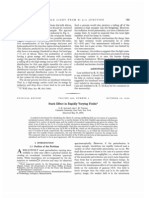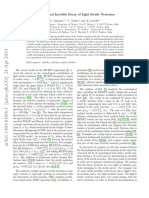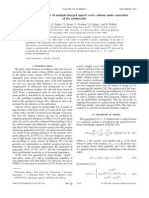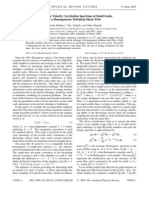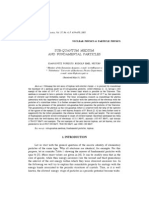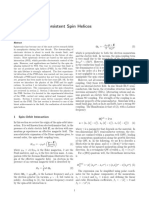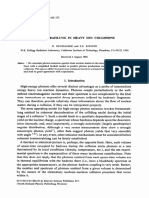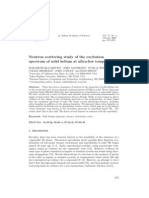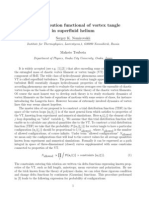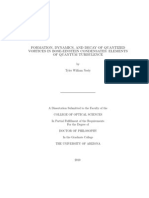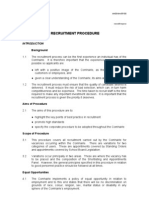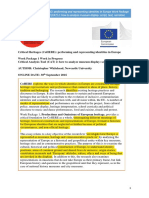Sergey Nazarenko and Miguel Onorato - Freely Decaying Turbulence and Bose-Einstein Condensation in Gross-Pitaevski Model
Sergey Nazarenko and Miguel Onorato - Freely Decaying Turbulence and Bose-Einstein Condensation in Gross-Pitaevski Model
Uploaded by
JuaxmawCopyright:
Available Formats
Sergey Nazarenko and Miguel Onorato - Freely Decaying Turbulence and Bose-Einstein Condensation in Gross-Pitaevski Model
Sergey Nazarenko and Miguel Onorato - Freely Decaying Turbulence and Bose-Einstein Condensation in Gross-Pitaevski Model
Uploaded by
JuaxmawOriginal Title
Copyright
Available Formats
Share this document
Did you find this document useful?
Is this content inappropriate?
Copyright:
Available Formats
Sergey Nazarenko and Miguel Onorato - Freely Decaying Turbulence and Bose-Einstein Condensation in Gross-Pitaevski Model
Sergey Nazarenko and Miguel Onorato - Freely Decaying Turbulence and Bose-Einstein Condensation in Gross-Pitaevski Model
Uploaded by
JuaxmawCopyright:
Available Formats
Journal of Low Temperature Physics, Vol. 146, Nos. 1/2, January 2007 ( 2006) DOI: 10.
1007/s10909-006-9271-z
Freely decaying Turbulence and BoseEinstein Condensation in GrossPitaevski Model
Sergey Nazarenko1 and Miguel Onorato2
Mathematics Institute, The University of Warwick, Coventry, CV4-7AL, U.K. 2 Dipartimento di Fisica Generale, Universit` di Torino, a Via P. Giuria, 1, Torino, 10125, Italy E-mail: snazar@warwick.ac.uk
1
We study turbulence and BoseEinstein condensation (BEC) within the twodimensional GrossPitaevski (GP) model. In the present work, we compute decaying GP turbulence in order to establish whether BEC can occur without forcing and if there is an intensity threshold for this process. We use the wavenumberfrequency plots which allow us to clearly separate the condensate and the wave components and, therefore, to conclude if BEC is present. We observe that BEC in such a system happens even for very weakly nonlinear initial conditions without any visible threshold. BEC arises via a growing phase coherence due to anihilation of phase defects/vortices. We study this process by tracking of propagating vortex pairs. The pairs loose momentum by scattering the background sound, which results in gradual decrease of the distance between the vortices. Occasionally, vortex pairs collide with a third vortex thereby emitting sound, which can lead to more sudden shrinking of the pairs. After the vortex anihilation the pulse propagates further as a dark soliton, and it eventually bursts creating a shock. PACS Numbers: 47.27.E-, 47.32.cd, 67.40.Fd, 67.40.Vs.
1. BACKGROUND AND MOTIVATION For dilute gases with large energy occupation numbers the Bose-Einstein condensation (BEC)13 can be described by the Gross Pitaevsky (GP) equation4,5 : i
t
| |2
= 0,
(1)
where is the condensate wave function. GP equation also describes light behavior in media with Kerr nonlinearities.
31
0022-2291/07/0100-0031/0 2006 Springer Science+Business Media, LLC
32
S. Nazarenko and M. Onorato
Many interesting features were found in GP turbulence in both the nonlinear optics and BEC contexts.1114,6,15 Initial elds, if weak, behave as wave turbulence (WT) where the main nonlinear process is a four-wave resonant interaction described by a four-wave kinetic equation.12 This closure was used in 11,13,14 to describe the initial stage of BEC. It was also theoretically predicted that the four-wave WT closure will eventually fail due to emergence of a coherent condensate state which is uniform in space.14 At this stage the nonlinear dynamics can be represented as interactions of small perturbations about the condensate state. Once again, one can use WT to describe such a system, but now the leading process will be a three-wave interaction of acoustic-like waves on the condensate background.14 Coupling of such acoustic turbulence to the condensate was considered in Ref. 16 which allowed to derived the asymptotic law of the condensate growth. In Ref. 7, the stage of transition from the four-wave to the threewave WT regimes, which itself is a strongly nonlinear process involving a gas of strongly nonlinear vortices, was studied. These vortices anihilate and their number reduces to zero in a nite time, marking a nite-time growth of the correlation length of the phase of to innity. This is similar to the KibbleZurek mechanism of the early Universe phase transitions which has been introduced originally in cosmology.17,18 It has been established that the vortex anihilation process is aided by the presence of sound and it becomes incomplete if sound is dissipated. Fourier transforms in both space and time were analysed using the wavenumberfrequency plots which, in case of weak wave turbulence, are narrowly concentrated around the linear dispersion relation = k . At the initial stage, narrow (k, )-distributions around = k = k 2 , were seen whereas at late evolution stages we saw two narrow components: a condensate at horizontal line = = | |2 and an acoustic component in proximity of the Bogolyubov curve 4 2 k = + k +2 k . In Ref. 7, the system was continuously forced at either large or small scales because this is a classical WT setting. WT predictions were conrmed for the energy spectra of GP turbulence. However, it remained unclear if presence of forcing is essential for complete BEC process, and whether there is any intensity threshold for this process in the absence of forcing. This questions are nontrivial because, in principle, even a weakly forced system could behave very differently from the forced one due to an innite supply of particles over long time. In the present paper we will examine these questions via numerical simulations of the 2D GP model without forcing. In addition, we will carefully examine and describe the essential stages of the typical route to the vortex anihilation leading to BEC. In many ways our work is closely
Turbulence and BoseEinstein Condensation
33
related with numerical studies of decaying 3D GP turbulence of Ref. 6, where transition from the 4-wave WT regime to condensation and superuidity was studied by visualising emergence and decay of a superuid vortex tangle. However, our work addresses additional issues which were not discussed in the previous papers, particularly emergence and dispersive properties of the 3-wave acoustic turbulence, crucial role of sound for the vortex decay process, separating the wave and the condensate components using novel numerical diagnostics based on (k, )-distributions. Below, we will only describe our numerical setup and results. For a summary of WT theory and its predictions in the GP context we refer to our previous paper.7 2. SETUP FOR NUMERICAL EXPERIMENTS In this paper we consider a setup corresponding to homogeneous turbulence and, therefore, we ignore nite-size effects due to magnetic trapping in BEC or to the nite beam radii in optical experiments. For numerical simulations, we have used a standard pseudo-spectral method8 for the 2D Eq. (1): the nonlinear term is computed in physical space while the linear part is solved exactly in Fourier space. The integration in time is performed using a second-order RungeKutta method. The number of grid points in physical space was set to N N with N = 256. Resolution in Fourier space was k = 2/N . Sink at high wave numbers was provided by adding to the right hand side of Eq. (1) the hyper-viscosity term ( 2 )n . Values of and n were selected in order to localized as much as possible dissipation to high wave numbers but avoiding at the same time the bottleneck effecta numerical artifact of spectrum pileup at the smallest scales.9 Note that importance of introducing the small-scale dissipation to eliminate the bottleneck effect has long been realised in numerical simulations of classical NavierStokes uids, and it was also recently realised in the context of GP turbulence in Ref. 10. We have found, after a number of trials, that = 2 106 and n = 8 were good choices for our purposes. Time step for integration was depended on the initial conditions. For strong nonlinearity smaller time step were required. Numerical simulations were performed on a PowerPC G5, 2.7 Ghz. Initial conditions were provided by the following: (kx , ky , t = 0) = 1/2 e
(kk0 )2 2 2
ei ,
(2)
2 2 where k = kx + ky . is a real number which was varied in order to change the nonlinearity of the initial condition for different simulations.
34
S. Nazarenko and M. Onorato
= (kx , ky ) are uniformly distributed random numbers in the interval [0, 2 ]. The simulations that will be presented here have been obtained with k0 = 35 k and = 5 k. The nonlinearity of the initial condition was measured as = k0 . We have performed simulations ranging from min = 0.018 to max = 1.3, so we have spanned almost two decades of nonlinear parameter in the initial conditions. 3. NUMERICAL RESULTS 3.1. Evolving Spectra We start by examining the most popular turbulence object, the spectrum, nk = |
2 k|
Since we study the setup corresponding to BEC, we start with a spectrum concentrated at high wavenumbers leaving a range of smaller wavenumbers initially empty so that it could be lled during the evolution. In Figs. 1 and 2 we show the spectra at different times for the strongest and the weakest nonlinear initial condition we have analyzed. At early stages, for both small and large initial intensities, we see propagation of the spectrum toward lower wavenumbers. However, we do not observe formation of a scaling range corresponding to the wave energy
Fig. 1. Spectra at different times for the initial condition characterized by = 1.3.
Turbulence and BoseEinstein Condensation
35
Fig. 2. Spectra at different times for the initial condition characterized by = 0.018.
equipartition nk 1/k = 1/k 2 (i.e. energy density k nk is constant in the 2D k-space) as it was the case in the simulations with continuous forcing.7 At later stages, no matter how small the initial intensity is, the low-k front reaches the smallest wavenumber and we observe steepening reaching slope 3.5 for large initial intensities (Fig. 1) and 1 for the weakest initial data (Fig. 2). This corresponds to WT breakdown and onset of BEC. However, the information contained in spectrum nk is very incomplete as it does not allow to distinguish between the coherent condensate and random waves that may both occupy the same wavenumber range. Thus, we turn to study the direct measures of condensation such as the correlation length and the wavenumber-frequency plots. 3.2. Explosive Growth of Correlation Length By denition, condensate is a coherent structure whose correlation length is of the same order as the bounding box. We dene the correlation length directly based on the auto-correlation function of eld , C (r) = R (x)R (x + r) / R (x)2 , (3)
where R denotes the real part of (result based on the imaginary part would be equivalent). Correlation length can be dened as 2 =
0 r0
C (r)dr,
(4)
36
S. Nazarenko and M. Onorato
Fig. 3. Evolution in time of the inverse square of the correlation length for different nonlinearity.
where r0 is the rst zero of C (r). Note that initially C (r) can strongly oscillate, which is a signature of weakly nonlinear waves. However, only one oscillation (i.e. within the rst zero crossing) is relevant to the condensate, which explains our denition of . Figure 3 shows evolution of 1/2 which, as we see that always reaches the box size wich is a signature of BEC. 3.3. WavenumberFrequency Plots As we discussed above, the spectra cannot distinguish between random waves and coherent structures especially when they are present simultaneously and overlap in the k-space. Besides, the spectra do not tell us if the wave component is weakly or strongly nonlinear. To resolve these ambiguities, following,7 let us perform an additional Fourier transform over a window of time and examine the resulting (k, )-plots of space time Fourier coefcients. Figure 4 corresponds to an early time of the system with relatively weak initial intensity ( = 0.4). We see that the distribution is narrowly concentrated near = k 2 which indicates that these waves are weakly
Turbulence and BoseEinstein Condensation
37
Fig. 4. (Color on-line) (k, ) plot for the initial stage for the case of = 0.4. Solid curve shows the Bogolyubov dispersion relation.
nonlinear. The weak nonlinear effects manifestate themselves in a small up-shift and broadening of the (k, )-distribution with respect to the = k 2 curve. For sufciently small initial intensities, these early stages of evolution are characterised by weak 4-wave turbulence. The breakdown of the = k 2 curve at high ks occurs due to the the numerical dissipation in the region close to the maximal wavenumber (this component is weak but clearly visible because the color map is normalised to the maximal value of the spectrum at each xed k). Figure 5 shows a late-time plot for the same run (i.e. = 0.4). The late-stage (k, )-plots for the most nonlinear intensities are in shown in Fig. 6. We see that in both cases we now see two clearly separated components quite narrowly concentrated around the following curves: (A) A horizontal line with , (B) The upper curve which follows the Bogolyubov curve = + k4 + 2 k2 .
k=
Component (A) corresponds to BEC. Its coherency can be seen in the fact that the frequency of different wavenumbers is the same. Note that usually BEC is depicted as a component with the lowest possible wavenumber in the system, whereas in our case we see a spread over, although small, but nite range of wavenumbers. This wavenumber spread is caused by few remaining deffects/vortices. Curve (B) corresponds the Bogolyubov sound-like waves. We see that the the (k, )-distribution is quite narrow and close to the Bogolyubov dispersion curve, which indicates that these waves are weakly nonlin-
38
S. Nazarenko and M. Onorato
Fig. 5. (Color on-line) (k, ) plot for the late stage for the case of = 0.4. Solid curve shows the Bogolyubov dispersion relation.
ear. However, now these weakly nonlinear waves travel on a strongly nonlinear BEC background. This is a three-wave acoustic weak turbulence regime.7,14,16 3.4. Separating the Condensate and the Wave Components Using the WavenumberFrequency plots we can separate BEC and the wave component and plot their spectra separately. In Fig. 7 we show the spectrum for the case of = 1.3 at late time for the condensate and the rest of the wave eld. These spectra have been obtained by integrating the ( k) from 0 to a threshold c (this corresponds to condensate) and from c to the maximum value of considered. In the present case, in order to separate the condensate, c was set to 1.5 (see Fig. 6). As is clear from the the gure, most of the energy is concentrated in the condensate. 3.5. Typical Events Leading to Vortex Anihilation Vortices are phase deffects of and, therefore, the correlation length growth is intimately connected with the decrease of the total number of vortices. As argued in Ref. 7 that Nvortices 1/2 . To give an illustration of the anihilation process we show in Fig. 8 two snapshots of | (x, y, t)|
Turbulence and BoseEinstein Condensation
39
Fig. 6. (Color on-line) ( k) plot for the latest stages for the most nonlinear case, = 1.3. Solid curve shows the Bogolyubov dispersion relation.
Fig. 7. Total wave spectrum (solid line), condensate wave spectrum (dotted line) and background wave spectrum (dotted line).
at different times. The vortices are seen as blue spots in these snapshots and we see a considerable decrease of their number at the later time (on the right). It was shown in Ref. 7 that Bogolyubov sound is an essential mediator in the vortex anihilation process, and that introducing a sound absorption can lead to frustration and incompleteness of the BEC process. Let us now examine in detail the typical sequence of events leading to the vortex annihilation by tracking vortex pairs that are destined to anihi-
40
S. Nazarenko and M. Onorato
Fig. 8. (Color on-line) | (x, y, t))| at two different instants of time.
late. The vortex pair motion is best seen in a computer generated movie which is available upon request from the authors. In Figs. 912 we show a representative sequence of frames from this movie. We can see that the vortex pair forms in frames ac so that the distance between the vortices in the pair is considerably less than distance to the other vortices. Such a pair propagates like a vortex dipole in uid, as seen in frames cf. During this propagation, the vortex pair scatters the ambient sound waves thereby transferring its momentum to the acoustic eld. This momentum loss make vortices get closer to each other and, therefore, move faster as a pair. This process can be interpreted as a friction between the vortices and a normal component (phonons). It is easy to show that such process leads to the change of distance d(t) between the vortices like d(t) = t A t, (5)
where coefcient is proportional to the energy density of sound and t A is the anihilation time. Fig. 13 shows evolution of the inter-vortex distance d(t), calculated for the vortex pair and the time range of Fig. 9. We see that for the time range when the vortex pair is more or less isolated from the other vortices, 11 < t < 40, the inter-vortex distance shrinks in qualitative agreement with law (5). However, immediately after that, in frame h in Fig. 10, the vortex pair collide with a third vortex and suddenly shrink and anihilate. Further on the movie we see that the vortex pair momentum was not completely lost and it keep propagating a Jones-Roberts dark soliton.19 In between of frames h and o the soliton cannot make up his
Turbulence and BoseEinstein Condensation
41
Fig. 9. (Color on-line) Frames af from a movie.
42
S. Nazarenko and M. Onorato
Fig. 10. (Color on-line) Frames ho from a movie.
Turbulence and BoseEinstein Condensation
43
Fig. 11. (Color on-line) Frames pu from a movie.
44
S. Nazarenko and M. Onorato
Fig. 12. (Color on-line) Frames vz from a movie.
mind oscillating between the state with and without vortices near the vortex anihilation threshold, until frame p where it re-emerges as a vortex pair. It collides with yet another vortex and changes its propagation direction to 90 in between of frames q and r, it annihilates again in frame s, propagates as a dark soliton until frame v. Eventually, this soliton is weakened due to further sound generation and scattering and it becomes too weak to maintain its stability and integrity. At this point it bursts thereby generating a shock wave as seen in frames vy. Summarizing, we can identify the following important events on the route to vortex anihilation: Gradual shrinking of the inter-vortex distance due to the sound scattering when the vortex pair is sufciently isolated from the rest of the vortices,
Turbulence and BoseEinstein Condensation
45
Fig. 13. Distance between the two vortices as a function of time for the vortex pair and the time range of Figure 9.
sudden shrinking events due to collisions with a third vortex and resulting sound generation (similar three-vortex event was described in Ref. 20), post-anihilation propagation of dark solitons, occasional recovery of vortex pairs in dark solitons which are close to the critical amplitude, weakening and loss of stability of the dark solitons resulting in a shock wave. 4. CONCLUSIONS We have computed decaying GP turbulence in a 2D periodic box with initial spectrum occupying the small-scale range. We observed that BEC at large scales arises for any initial intensity without a visible threshold, even for very weakly nonlinear initial conditions. BEC was detected by analysing the spectra and the correlation length and, most clearly, by analysing the (k, ) plots. On these plots BEC and Bogolyubov waves are seen as two clearly distinct components: (i) BEC coherently oscillating at nearly constant frequency and (ii) weakly nonlinear waves closely following the
46
S. Nazarenko and M. Onorato
Bogolyubov dispersion. By separating BEC and the waves we observed that most of the energy at late times is residing in the BEC component at most of the important scales except for the smallest ones. We also analysed the typical events on the path to vortex anihilation, an essential mechanism of BEC. ACKNOWLEDGMENTS Al Osborne is acknowledged for discussions in the early stages of the work. REFERENCES
1. M. H. Anderson, J. R. Ensher, M. R. Matthews, C. E. Wieman, and E. A. Cornell, Science 269, 198 (1995). 2. C. C. Bradley, C. A. Sackett, J. J. Tollett, and R. G. Hulet, Phys. Rev. Lett. 75, 16871690 (1995). 3. K. B. Davis, M. -O. Mewes, M. R. Andrews, N. J. van Druten, D. S. Durfee, D. M. Kurn, and W. Ketterle, Phys. Rev. Lett. 75, 3969 (1995). 4. E. P. Gross, Nuovo Cimento 20, 454 (1961). 5. L. P. Pitaevsky, Sov. Phys. JETP 13, 451 (1961). 6. N. G. Berloff and B. V. Svistunov, Phys. Rev. A 66, 013603 (2002). 7. S. Nazarenko and M. Onorato, Physica D 219, 1 (2006). 8. B. Fornberg, A Practical Guide to Pseudospectral Methods, Cambridge Monographs on Applied and Computational Mathematics, (No. 1) (cambridge university press, 1999). 9. G. Falkovich, Phys. Fluids 6, Issue 4 (1994). 10. M. Kobayashi and M. Tsubota, Phys. Rev. Lett. 94, 065302 (2005). 11. Yu. M. Kagan, B. V. Svistunov, and G. P. Shlyapnikov, Sov. Phys. JETP 75, 387 (1992). 12. V. E. Zakharov, S. L. Musher, and A. M. Rubenchik, Phys. Rep. 129, 285 (1985). 13. D. V. Semikoz and I. I. Tkachev, Phys. Rev. Lett. 74, 3093 (1995). 14. A. Dyachenko, A. C. Newell, and A. Pushkarev, Physica D 57, 96 (1992). 15. Y. Pomeau, Nonlinearity 5, 707 (1992). 16. V. E. Zakharov and S. V. Nazarenko, Physica D 201, 203 (2005). 17. T. W. B. Kibble, J. Phys. A: Math. Gen. 9, 1387 (1976). 18. W. H. Zurek, Nature 317, 505 (1985); Acta Physica Polonica B 24, 1301 (1993). 19. C. A. Jones and P. H. Roberts, J. Phys. A: Math. Gen. 15, 2599 (1982). 20. C. F. Barenghi, N. G. Parker, N. P. Proukakis, and C. S. Adams, J. Low Temperature Physics 138, 629 (2005).
You might also like
- Stark Effect in Rapidly Varying FieldsDocument20 pagesStark Effect in Rapidly Varying FieldsKrishna TripathiNo ratings yet
- International Counseling Model Handbook PDFDocument95 pagesInternational Counseling Model Handbook PDFDiadeeaNo ratings yet
- K. Nakamura Et Al - Levitation of Spinor Bose-Einstein Condensates: Macroscopic Manifestation of The Franck-Condon EffectDocument8 pagesK. Nakamura Et Al - Levitation of Spinor Bose-Einstein Condensates: Macroscopic Manifestation of The Franck-Condon EffectPomac232No ratings yet
- Cosmological Invisible Decay of Light Sterile Neutrinos: PACS Numbers: 14.60.Pq, 14.60.Lm, 14.60.St, 98.80.-kDocument5 pagesCosmological Invisible Decay of Light Sterile Neutrinos: PACS Numbers: 14.60.Pq, 14.60.Lm, 14.60.St, 98.80.-kStefano GariazzoNo ratings yet
- Stability and Signatures of Biexcitons in Carbon Nanotubes: Thomas G. Pedersen and Kjeld PedersenDocument4 pagesStability and Signatures of Biexcitons in Carbon Nanotubes: Thomas G. Pedersen and Kjeld PedersenemediageNo ratings yet
- Axion Cold Dark Matter: Status After Planck and BICEP2: PACS Numbers: 98.80.-k 95.85.Sz, 98.70.Vc, 98.80.CqDocument9 pagesAxion Cold Dark Matter: Status After Planck and BICEP2: PACS Numbers: 98.80.-k 95.85.Sz, 98.70.Vc, 98.80.Cqhuevonomar05No ratings yet
- 9208007v2Document13 pages9208007v2Azerty AzertyNo ratings yet
- 2.57 Nano-to-Macro Transport Processes Fall 2004Document7 pages2.57 Nano-to-Macro Transport Processes Fall 2004captainhassNo ratings yet
- 2.57 Nano-to-Macro Transport Processes Fall 2004: I T KXDocument8 pages2.57 Nano-to-Macro Transport Processes Fall 2004: I T KXcaptainhassNo ratings yet
- Self-Induced Transparency Bragg Solitons in A Nonlinear Photonic Bandgap StructureDocument6 pagesSelf-Induced Transparency Bragg Solitons in A Nonlinear Photonic Bandgap StructureBridget GwenNo ratings yet
- Ani. 'Xtraterrestria.: OtonDocument20 pagesAni. 'Xtraterrestria.: Otontom12519No ratings yet
- MIT2 57S12 Lec Notes 2004 PDFDocument177 pagesMIT2 57S12 Lec Notes 2004 PDFGerman ToledoNo ratings yet
- Nonlinear Dynamics of Multi-Component Bose-Einstein CondensatesDocument13 pagesNonlinear Dynamics of Multi-Component Bose-Einstein CondensatesAnonymous b2k9ABe7eNo ratings yet
- A. M. Kamchatnov, A. Gammal and R. A. Kraenkel - Dissipationless Shock Waves in Bose-Einstein Condensates With Repulsive Interaction Between AtomsDocument4 pagesA. M. Kamchatnov, A. Gammal and R. A. Kraenkel - Dissipationless Shock Waves in Bose-Einstein Condensates With Repulsive Interaction Between AtomsJuaxmawNo ratings yet
- Electroweak TheoryDocument85 pagesElectroweak Theorytrieu laiNo ratings yet
- Dependence of Nuclear Binding On Hadronic Mass Variation: PACS Numbers: 98.80.Cq, 26.35.+c, 21.45.+vDocument28 pagesDependence of Nuclear Binding On Hadronic Mass Variation: PACS Numbers: 98.80.Cq, 26.35.+c, 21.45.+vBayer MitrovicNo ratings yet
- S. Wuster, T.E. Argue and C.M. Savage - Numerical Study of The Stability of Skyrmions in Bose-Einstein CondensatesDocument8 pagesS. Wuster, T.E. Argue and C.M. Savage - Numerical Study of The Stability of Skyrmions in Bose-Einstein CondensatesPomac232No ratings yet
- Theory Intensity Distribution Systems : OF in BandDocument20 pagesTheory Intensity Distribution Systems : OF in Bandseraiche100% (1)
- Applied Mathematical Modelling: Ben Evans, Ken Morgan, Oubay HassanDocument20 pagesApplied Mathematical Modelling: Ben Evans, Ken Morgan, Oubay HassanMark HannaNo ratings yet
- FIRASDocument21 pagesFIRASSoran KahtanNo ratings yet
- Richter 1992Document4 pagesRichter 1992Maria Cecilia Murillo AbadNo ratings yet
- 0222-0242Document21 pages0222-0242pra034987No ratings yet
- A.D. Dolgov and I.D. Novikov - Superluminal Propagation of Light in Gravitational Field and Non-Causal SignalsDocument18 pagesA.D. Dolgov and I.D. Novikov - Superluminal Propagation of Light in Gravitational Field and Non-Causal SignalsOppekeeNo ratings yet
- Gravitational Shielding 2Document2 pagesGravitational Shielding 2Adonis SorianoNo ratings yet
- A. Dreischuh Et Al - Modulational Instability of Multiple-Charged Optical Vortex Solitons Under Saturation of The NonlinearityDocument7 pagesA. Dreischuh Et Al - Modulational Instability of Multiple-Charged Optical Vortex Solitons Under Saturation of The NonlinearityKonnasderNo ratings yet
- V. Y. F. Leung, A. G. Truscott and K. G. H. Baldwin - Nonlinear Atom Optics With Bright Matter-Wave Soliton TrainsDocument4 pagesV. Y. F. Leung, A. G. Truscott and K. G. H. Baldwin - Nonlinear Atom Optics With Bright Matter-Wave Soliton TrainsLomewcxNo ratings yet
- Takashi Ishihara, Kyo Yoshida and Yukio Kaneda - Anisotropic Velocity Correlation Spectrum at Small Scales in A Homogeneous Turbulent Shear FlowDocument4 pagesTakashi Ishihara, Kyo Yoshida and Yukio Kaneda - Anisotropic Velocity Correlation Spectrum at Small Scales in A Homogeneous Turbulent Shear FlowPonmijNo ratings yet
- The Origin of Chemical Elements - 1948 - Gamow, Bethe, AlpherDocument2 pagesThe Origin of Chemical Elements - 1948 - Gamow, Bethe, Alpherstickygreenman100% (1)
- Tomoda, Faessler, SchmidDocument30 pagesTomoda, Faessler, Schmidzcapg17No ratings yet
- KompaneetsDocument8 pagesKompaneetsStamatis StathNo ratings yet
- Ioan-Iovitz Popescu and Rudolf Emil Nistor - Sub-Quantum Medium and Fundamental ParticlesDocument12 pagesIoan-Iovitz Popescu and Rudolf Emil Nistor - Sub-Quantum Medium and Fundamental ParticlesOppekeeNo ratings yet
- Lars Mohrmann - Search For Super-Heavy Magnetic Monopoles With The IceCube DetectorDocument14 pagesLars Mohrmann - Search For Super-Heavy Magnetic Monopoles With The IceCube DetectorUmav24No ratings yet
- HBTDocument52 pagesHBTFabiana MonteiroNo ratings yet
- T. Tatsuno, V. I. Berezhiani and S.M. Mahajan - Vortex Solitons - Mass, Energy and Angular Momentum Bunching in Relativistic Electron-Positron PlasmasDocument20 pagesT. Tatsuno, V. I. Berezhiani and S.M. Mahajan - Vortex Solitons - Mass, Energy and Angular Momentum Bunching in Relativistic Electron-Positron Plasmas23213mNo ratings yet
- Theoretical Summary Lecture For EPS HEP99Document41 pagesTheoretical Summary Lecture For EPS HEP99John BirdNo ratings yet
- PhysicsDocument10 pagesPhysicscdcrossroaderNo ratings yet
- Rle TR 113 04711211 - 2Document28 pagesRle TR 113 04711211 - 2kurniawanNo ratings yet
- Hypothesis of Tachyonic NeutrinosDocument9 pagesHypothesis of Tachyonic NeutrinosMarcus MagalhaesNo ratings yet
- LogicaDocument4 pagesLogicaspanishramNo ratings yet
- PhysRevLett 122 117402Document6 pagesPhysRevLett 122 117402iantyler329No ratings yet
- Research Institute For Fundmnental Physics Kyoto University, KyotoDocument20 pagesResearch Institute For Fundmnental Physics Kyoto University, KyotoWisang Elang Fajar NisnalaNo ratings yet
- Holes in A Two-Dimensional Quantum AntiferromagnetDocument38 pagesHoles in A Two-Dimensional Quantum AntiferromagnetsantoshkudNo ratings yet
- Review Persistent Spin HelicesDocument11 pagesReview Persistent Spin HelicesMarcAlomarPayerasNo ratings yet
- Analogue Simulation of Gravitational Waves in A 3 + 1 Dimensional Bose-Einstein CondensateDocument31 pagesAnalogue Simulation of Gravitational Waves in A 3 + 1 Dimensional Bose-Einstein CondensateDiana Catalina Riano ReyesNo ratings yet
- Impact Ionisation Rate and Soft Energy Thresholds For Anisotropic Parabolic Band StructuresDocument7 pagesImpact Ionisation Rate and Soft Energy Thresholds For Anisotropic Parabolic Band Structureslahoual70No ratings yet
- Pair Production BrezinDocument9 pagesPair Production Brezin11111__11__1111No ratings yet
- Dynamical Casimir Effect in Oscillating MediaDocument8 pagesDynamical Casimir Effect in Oscillating Mediaduchmateusz6528No ratings yet
- Twist-3 Contribution To Deeply Virtual Electroproduction of PionsDocument10 pagesTwist-3 Contribution To Deeply Virtual Electroproduction of Pionsa65853766No ratings yet
- Two-Photon Echo Method For Observing Electron Zitterbewegung in Carbon NanotubesDocument9 pagesTwo-Photon Echo Method For Observing Electron Zitterbewegung in Carbon NanotubescrocoaliNo ratings yet
- PressorsDocument14 pagesPressorsMSD fanNo ratings yet
- Dynamical Superfluid-Insulator Transition in A Chain of Weakly Coupled Bose-Einstein CondensatesDocument5 pagesDynamical Superfluid-Insulator Transition in A Chain of Weakly Coupled Bose-Einstein CondensatescdcrossroaderNo ratings yet
- Bremsstrahlung in Heavy Ion CollisionsDocument10 pagesBremsstrahlung in Heavy Ion Collisionsعین الله یاسینیNo ratings yet
- Acousto Optics Modulator 1Document9 pagesAcousto Optics Modulator 1SURESH SURAGANINo ratings yet
- 2.57 Nano-To-Macro Transport Processes Fall 2004: Ikn A IkxDocument7 pages2.57 Nano-To-Macro Transport Processes Fall 2004: Ikn A IkxcaptainhassNo ratings yet
- R. Carretero-Gonzalez Et Al - Soliton Trains and Vortex Streets As A Form of Cerenkov Radiation in Trapped Bose-Einstein CondensatesDocument9 pagesR. Carretero-Gonzalez Et Al - Soliton Trains and Vortex Streets As A Form of Cerenkov Radiation in Trapped Bose-Einstein CondensatesLomewcxNo ratings yet
- Answer To Pozar Exercise 1-1Document11 pagesAnswer To Pozar Exercise 1-1John Bofarull GuixNo ratings yet
- MIT OCW Wave Propagation Lecture Part 5Document22 pagesMIT OCW Wave Propagation Lecture Part 5Mohan NayakaNo ratings yet
- The Sunyaev-Zel'dovich Effect in Cosmology and Cluster PhysicsDocument31 pagesThe Sunyaev-Zel'dovich Effect in Cosmology and Cluster PhysicspjblkNo ratings yet
- Clusters of Galaxies in The Radio: Relativistic Plasma and ICM/Radio Galaxy Interaction ProcessesDocument34 pagesClusters of Galaxies in The Radio: Relativistic Plasma and ICM/Radio Galaxy Interaction ProcessespjblkNo ratings yet
- Negative Mass and Negative Refractive Index in Atom Nuclei - Nuclear Wave Equation - Gravitational and Inertial Control: Part 2: Gravitational and Inertial Control, #2From EverandNegative Mass and Negative Refractive Index in Atom Nuclei - Nuclear Wave Equation - Gravitational and Inertial Control: Part 2: Gravitational and Inertial Control, #2No ratings yet
- D. Iftimie Et Al - On The Large Time Behavior of Two-Dimensional Vortex DynamicsDocument10 pagesD. Iftimie Et Al - On The Large Time Behavior of Two-Dimensional Vortex DynamicsJuaxmawNo ratings yet
- Physics Department, Case Western Reserve University, Cleveland, Ohio 44106Document8 pagesPhysics Department, Case Western Reserve University, Cleveland, Ohio 44106JuaxmawNo ratings yet
- Yuichi Okuda and Ryuji Nomura - Physics of Quantum Solid in MicrogravityDocument8 pagesYuichi Okuda and Ryuji Nomura - Physics of Quantum Solid in MicrogravityJuaxmawNo ratings yet
- Yuichi Okuda, Takao Mizusaki and Makio Uwaha - Basic Research On Crystal Growth and Surface Physics of Solid Helium Under MicrogravityDocument6 pagesYuichi Okuda, Takao Mizusaki and Makio Uwaha - Basic Research On Crystal Growth and Surface Physics of Solid Helium Under MicrogravityJuaxmawNo ratings yet
- X. Rojas Et Al - Acoustic Properties of Solid Helium 4 in The Limit of Zero ImpurityDocument6 pagesX. Rojas Et Al - Acoustic Properties of Solid Helium 4 in The Limit of Zero ImpurityJuaxmawNo ratings yet
- Oleksandr Syshchenko, James Day and John Beamish - Frequency Dependence and Dissipation in The Dynamics of Solid HeliumDocument4 pagesOleksandr Syshchenko, James Day and John Beamish - Frequency Dependence and Dissipation in The Dynamics of Solid HeliumJuaxmawNo ratings yet
- G. Benedek, P. Nieto and J.P. Toennies - The Geyser Effect in The Expansion of Solid Helium Into VacuumDocument13 pagesG. Benedek, P. Nieto and J.P. Toennies - The Geyser Effect in The Expansion of Solid Helium Into VacuumJuaxmawNo ratings yet
- Eugene B. Gordon - Matrix Isolation by Solid HeliumDocument1 pageEugene B. Gordon - Matrix Isolation by Solid HeliumJuaxmawNo ratings yet
- Elizabeth Blackburn Et Al - Neutron Scattering Study of The Excitation Spectrum of Solid Helium at Ultra-Low TemperaturesDocument6 pagesElizabeth Blackburn Et Al - Neutron Scattering Study of The Excitation Spectrum of Solid Helium at Ultra-Low TemperaturesJuaxmawNo ratings yet
- S. Sasaki Et Al - Supersolidity and Superfluidity of Grain BoundariesDocument6 pagesS. Sasaki Et Al - Supersolidity and Superfluidity of Grain BoundariesJuaxmawNo ratings yet
- W.J. Nellis - Discovery of Metallic Fluid Hydrogen at 140 GPa and Ten-Fold Compressed Liquid DensityDocument6 pagesW.J. Nellis - Discovery of Metallic Fluid Hydrogen at 140 GPa and Ten-Fold Compressed Liquid DensityJuaxmawNo ratings yet
- X. Chavanne, S. Balibar and F. Caupin - Acoustic Nucleation of Solid Helium 4 On A Clean Glass PlateDocument10 pagesX. Chavanne, S. Balibar and F. Caupin - Acoustic Nucleation of Solid Helium 4 On A Clean Glass PlateJuaxmawNo ratings yet
- Shin-Ichiro Ogawa Et Al - Method To Create A Vortex in A Bose-Einstein CondensateDocument7 pagesShin-Ichiro Ogawa Et Al - Method To Create A Vortex in A Bose-Einstein CondensateJuaxmawNo ratings yet
- Bryan Daniels - Nonclassical Rotational Inertia in Solid Helium-FourDocument12 pagesBryan Daniels - Nonclassical Rotational Inertia in Solid Helium-FourJuaxmawNo ratings yet
- J. Eggert Et Al - Observation of Metallic Helium: Equation of State and Transport Measurements Under Astrophysical ConditionsDocument1 pageJ. Eggert Et Al - Observation of Metallic Helium: Equation of State and Transport Measurements Under Astrophysical ConditionsJuaxmawNo ratings yet
- Sergey K. Nemirovskii and Makoto Tsubota - Trial Distribution Functional of Vortex Tangle in Superfluid HeliumDocument2 pagesSergey K. Nemirovskii and Makoto Tsubota - Trial Distribution Functional of Vortex Tangle in Superfluid HeliumJuaxmawNo ratings yet
- Victor S. L'vov, Sergei V. Nazarenko and Oleksii Rudenko - Bottleneck Crossover Between Classical and Quantum Superfluid TurbulenceDocument9 pagesVictor S. L'vov, Sergei V. Nazarenko and Oleksii Rudenko - Bottleneck Crossover Between Classical and Quantum Superfluid TurbulenceJuaxmawNo ratings yet
- Tyler William Neely - Formation, Dynamics, and Decay of Quantized Vortices in Bose-Einstein Condensates: Elements of Quantum TurbulenceDocument153 pagesTyler William Neely - Formation, Dynamics, and Decay of Quantized Vortices in Bose-Einstein Condensates: Elements of Quantum TurbulenceJuaxmawNo ratings yet
- Carlo F. Barenghi - Is The Reynolds Number Infinite in Superfluid Turbulence?Document8 pagesCarlo F. Barenghi - Is The Reynolds Number Infinite in Superfluid Turbulence?JuaxmawNo ratings yet
- E.A.L. Henn Et Al - Generation of Vortices and Observation of Quantum Turbulence in An Oscillating Bose-Einstein CondensateDocument6 pagesE.A.L. Henn Et Al - Generation of Vortices and Observation of Quantum Turbulence in An Oscillating Bose-Einstein CondensateJuaxmawNo ratings yet
- S.Wang Et Al - Two-Particle Separation in The Point Vortex Gas Model of Superfluid TurbulenceDocument13 pagesS.Wang Et Al - Two-Particle Separation in The Point Vortex Gas Model of Superfluid TurbulenceJuaxmawNo ratings yet
- Hai-Jun Wang Et Al - Scattering of Electrons by A Bose-Einstein Condensate of Alkali-Metal AtomsDocument7 pagesHai-Jun Wang Et Al - Scattering of Electrons by A Bose-Einstein Condensate of Alkali-Metal AtomsJuaxmawNo ratings yet
- 12 BibliographyDocument13 pages12 BibliographyBarbi DunaiNo ratings yet
- Math Anxiety and Its Effects1Document6 pagesMath Anxiety and Its Effects1Indra Kumari BajracharyaNo ratings yet
- Recruitment ProcedureDocument50 pagesRecruitment ProcedureSakshi ThakurNo ratings yet
- Vedic MathematicsDocument55 pagesVedic MathematicsBalaji Kumar100% (1)
- CV4011-PT1 Lecturenote 4-Or - CPM 1516 S1Document17 pagesCV4011-PT1 Lecturenote 4-Or - CPM 1516 S1Steven KuaNo ratings yet
- Professional PracticesDocument179 pagesProfessional PracticesApex DevelopersNo ratings yet
- The Importance of FamilyDocument7 pagesThe Importance of FamilyKalai ShanNo ratings yet
- Transcription GuideDocument3 pagesTranscription GuideAte JaiNo ratings yet
- Whitehead CAT How Analyze Museum DisplayDocument20 pagesWhitehead CAT How Analyze Museum DisplayS. AmarantNo ratings yet
- Tok Prompts ExplainedDocument17 pagesTok Prompts ExplainedashkamooreNo ratings yet
- List of Naga RajasDocument26 pagesList of Naga RajasSri HariNo ratings yet
- LatinskiDocument4 pagesLatinskiSanja SpasojevicNo ratings yet
- Changing Gender RolesDocument2 pagesChanging Gender RolesLaura CristinaNo ratings yet
- Cassirer Substance and Function Einsteins RelativityDocument492 pagesCassirer Substance and Function Einsteins Relativitymilutin1987100% (1)
- Comparativegrammar Sanskrit Greek Latin Latvian GermanDocument490 pagesComparativegrammar Sanskrit Greek Latin Latvian Germanfisico gamerNo ratings yet
- ME Soft ComputingDocument6 pagesME Soft Computingmarshel007No ratings yet
- Bjork Essay EditedDocument13 pagesBjork Essay EditedKai WikeleyNo ratings yet
- How To MeditateDocument4 pagesHow To MeditatecrinanovacNo ratings yet
- Be Strong, Be Healthy, Be SmartDocument2 pagesBe Strong, Be Healthy, Be SmartShemah Eliza LimNo ratings yet
- Community Conversations Immigration ToolkitDocument10 pagesCommunity Conversations Immigration ToolkitNew York Council for the HumanitiesNo ratings yet
- Mock Test Four: Uee Preparation Course 2019-2020Document3 pagesMock Test Four: Uee Preparation Course 2019-2020213124No ratings yet
- Weebly Verbal Linguistic Mi LessonDocument2 pagesWeebly Verbal Linguistic Mi Lessonapi-228235312No ratings yet
- ClaimsDocument23 pagesClaimsDaniel CayabyabNo ratings yet
- Appeal To PityDocument3 pagesAppeal To PityJeremias De la CruzNo ratings yet
- Celis Vs CafuirDocument2 pagesCelis Vs CafuirPeace Marie PananginNo ratings yet
- Feminist Ethics: John Martin FischerDocument12 pagesFeminist Ethics: John Martin Fischerlukman al hakimNo ratings yet
- PHIL 210 Course OutlineDocument3 pagesPHIL 210 Course OutlineHiru rNo ratings yet
- The Seventh Day Adventists - Sunday Study in CultsDocument30 pagesThe Seventh Day Adventists - Sunday Study in CultssirjsslutNo ratings yet
- IMPACT OF Gossip in The WorkplaceDocument2 pagesIMPACT OF Gossip in The WorkplaceAna Maria D. AlmendralaNo ratings yet
